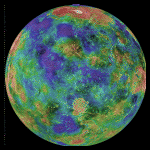 |
|||||||
| VENUS IS A BURNING-DESERT WORLD | |||||||
|---|---|---|---|---|---|---|---|
| Planet | Water | Greenhouse | Lightning | Spacecraft | Express | Transit | Resources |
 |
|||||||
| VENUS IS A BURNING-DESERT WORLD | |||||||
|---|---|---|---|---|---|---|---|
| Planet | Water | Greenhouse | Lightning | Spacecraft | Express | Transit | Resources |
Venus is one of nine known major planets of the Solar System. The others are Mercury, Earth, Mars, Jupiter, Saturn, Uranus, Neptune and Pluto. Venus is the second planet out from the Sun, between Mercury and Earth.
Hubble Space Telescope image of Venus
Venus is one of the four rocky metallic planets nearest the Sun. Those four inner planets -- Mercury, Venus, Earth and Mars -- are referred to as terrestrial planets since they are much like our own planet Earth.
Even at its closest, Venus is 100 times farther away from Earth than the Moon. Venus is the sixth largest planet.
The planet is named for the ancient goddess of beauty because it the brightest object in Earth's sky after the Sun and the Moon. Most of the features on the surface of Venus also are named for female figures.
Desert world. Venus is a burning-desert world hidden under bitter clouds of sulfuric acid and carbon dioxide. It may once have been awash with oceans of near-boiling water.
For hundreds of millions of years, most of the water on Venus was liquid near the boiling point. But the water finally dried up, according to scientists at NASA's Ames Research Center in Mountain View, California, south of San Francisco.
In what they call a moist-greenhouse or wet-greenhouse effect, the water on Venus was able to remain liquid for a few hundred million years because planet temperatures actually were cooler than Earth scientists once thought, and because of the proportion of carbon dioxide to water vapor in the atmosphere of Venus.
Venusian seas dried up slowly as hydrogen eventually escaped into space. Oxygen formed compounds with other elements and was incorporated into the planet's crust.


Images of Venus
Scientists say liquid water seems essential to life. The Ames researchers said the oceans of Venus might still have been liquid at 200 to 300 degrees Fahrenheit because of intense pressure. But that may have been too hot for life to begin. If not, it may not have lasted long enough for life to begin.
Greenhouse Effect. Venus is nearly a twin to Earth in size. However, it has atmospheric pressure on the surface 90 times that of Earth. The temperature on the surface of Venus may be as high as 900 degrees Fahrenheit.
Scientists already had a runaway-greenhouse explanation in which water existed on Venus, but only as vapor.In a greenhouse effect, Sun heat is trapped by gases in a planet's dense atmosphere.
The wet-greenhouse and the runaway-greenhouse theories have a greenhouse effect in common.
In the runaway-greenhouse explanation, Venus was said to be so hot that its water existed only as vapor and had no chance to condense to liquid on the surface. Water vapor rose into the atmosphere, where radiation from the Sun cracked it into separate oxygen and hydrogen atoms. The hydrogen escaped into space and water couldn't form.
But the Ames researchers, looking at different climates on Venus, Earth and Mars, didn't like the runaway-greenhouse explanation. That old theory forgot that the Sun was 25 to 30 percent cooler 4.5 billion years ago. It also did not account for the water loss.
NASA scientists have bounced radar waves off cloud-shrouded Venus and detected colossal highly-reflective blobs and rings that may be lava flows or volcano crater rims rich in fool's gold.
The radar survey by researchers from NASA's Jet Propulsion Laboratory (JPL), Pasadena, California, turned up more evidence that volcanoes have erupted on Venus within the last few million years, maybe even within recent centuries.
Learn more:
Venus
- Venus Planet Profile NASA JPL
- Venus Described SEDS Nine Planets
- Exploring Venus STO
- Exploring Venus index STO
- Planet Venus STO
- Venus Water STO
- Venus Greenhouse STO
- Venus Lightning STO
Venus Transit
- Venus Transit 2004 STO
- Guide to Viewing the Transit Science @ NASA
- Guide to Viewing the Transit Science @ NASA
- 2004 Venus Transit Resource Guide NASA Sun-Earth Connection
- Movies and diagrams of the transit Astronomy magazine
- Venus Transits of 2004 and 2012 NASA Goddard
- Guide to the Transit of Venus Sky & Telescope magazine
Captain James Cook
- James Cook and the Transit of Venus Science @ NASA
- James Cook and the Transit of Venus Blue Latitudes
- James Cook Journals National Library of Australia
- History of Cook's Endeavour HM Bark Endeavour Foundation
- James Cook Transit Timing Measurements Royal Society of London
- South Seas Voyaging National Library of Australia
- James Cook Drawings of 1769 Venus Transit Armagh Observatory
- Capt. Cook's Voyages Linda Hall Library History of Science
Exploring Venus and the Solar System
- Venus Spacecraft STO
- The Pioneers STO
- The Voyagers STO
- Exploring the Solar System STO
How to watch the Sun safely
- Safe Sunwatching Science @ NASA
- List of solar filter suppliers Sky & Telescope magazine
- Solar Filter Safety Sky & Telescope magazine
- Close-Up of a Star Sky & Telescope magazine
- A Beginner's Guide to Solar Observing Sky & Telescope magazine
Read more about the Solar System . . . Star: The Sun Inner Planets: Mercury Venus Earth Mars Outer Planets: Jupiter Saturn Uranus Neptune Pluto Other Bodies: Moons Asteroids Comets Beyond: Pioneers Voyagers